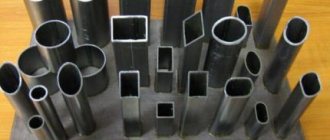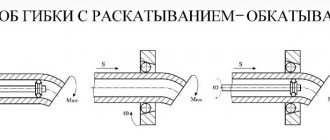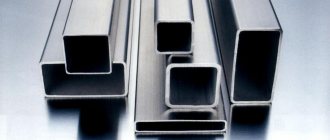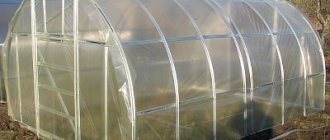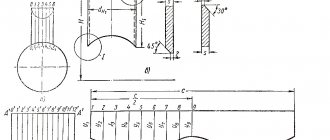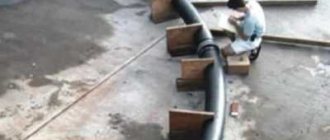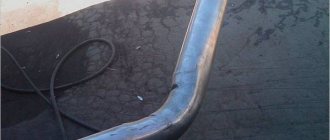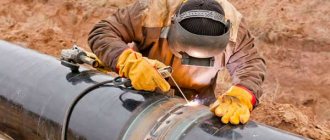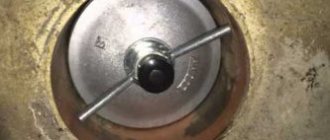Forged arches are perhaps the most popular solution for landscape design. Metal structures are valued for their reliability and safety of operation, durability, resistance to mechanical and weather influences, and attractive design.
Forged arches perform many functions : they act as a decorative element for the environment, serve as the basis for arranging vertical flower beds, and are part of a special event. An undoubtedly important advantage is the wide range of product shapes : arched, rectangular, mixed, original.
Photos of forged arches are collected and presented in the appropriate section. Home craftsmen have the opportunity to see examples of the work of experienced craftsmen below, choose the sketch they like and make a forged arch.
An alternative is to watch the video reviews below.
Possible complications during work
The actual bending of such a pipe is the process of giving the element a curved-smooth configuration. This can only be done under pressure, since the part has high strength. To reduce the pressure force required for bending, you can use heating of the bent fragment.
Despite the apparent simplicity of the operation, bending does not always result in elements of the desired configuration. Problems arise quite often. The most common complications include three.
The first is that the inner side of the profile folds in peculiar folds that resemble corrugation. In the correct version, it contracts evenly.
The industry produces many types of profile pipes. They differ in cross-sectional shape, profile height, wall thickness
The second difficulty is the rupture of the outer wall of the profile pipe. During bending it stretches. Sometimes the metal cannot withstand the force and bursts. The third problem is that the pipe, changing its shape, can lose the alignment of the elements.
This means that its fragments in a bent state will lie in different planes. And this is unacceptable. Practice shows that all difficulties occur due to the wrong choice of bending method.
To choose it correctly, you need to take into account the plastic capabilities of the profile pipe. They are determined by the size and shape of the section, as well as the thickness of the walls of the product. Based on these values, you can calculate the minimum possible radius of curvature. Trying to make a round with a smaller radius is strongly discouraged.
To determine the minimum radius, we need the height of the section. It is calculated as follows. The height of the profile is measured, and twice the wall thickness of the product is subtracted from it.
The resulting number will be the desired height, let's denote it h. For pipes with a cross-section in the shape of a rectangle and square, the following rule applies. If the profile height is above 20 mm, the part can withstand bending in a section whose minimum length is hx3.5.
Products with a profile below 20 mm can be bent over a length of hx2.5 or more. This rule applies to all pipes. However, the wall thickness of the part also affects bending limitations.
The thinner it is, the higher the likelihood of a rupture or crushing of the part. Experts strongly do not recommend trying to bend wide products with wall thickness less than 2 mm. In this case, it is optimal to use a welding machine.
When bending a profile pipe, it is very important to perform all actions correctly and carefully, otherwise the part may lose alignment or become wrinkled. This pipe cannot be used
One more thing to be aware of. Pipes made of low-alloy and carbon alloys are very elastic and, after bending, can seem to “spring”, trying to take their previous shape.
This involves additional work with the product, since it will have to be adjusted again according to a pre-made template. Therefore, it is recommended to find out the value of the plastic moment of resistance of a given profile pipe and carry out bending taking this indicator into account. The smaller it is, the less the part will “spring”.
Metal arch
Mounting a metal arch occurs using reinforcing rods with a diameter of at least 10 centimeters, primer, flexible wire and rope.
Work steps:
- When making a workpiece from reinforcement, you need to use metal pins, the length of which is one-fourth of a meter, driven into the ground along the counter.
- Then we create connecting rings for the prepared racks from reinforcement. Then you need to cut 9 pieces of reinforcement and bend them into rings using a pipe bender.
- Next, the reinforcing fastening rings for the racks are fastened using flexible wire, and they need to be raised from the ground level by no less than 0.5 meters. The distance between the rings should be 20 cm.
- To prevent the finished garden arch from corroding, you need to cover it with a primer and then oil paint. At this stage, the arch manufacturing process is completed.
Features of different profile bending methods
There are two main methods of bending profile pipes: cold and hot. The first assumes that the bending process is carried out without preliminary temperature exposure to the part.
While the second is carried out only with a preheated pipe. It must be admitted that heating the part significantly increases its ductility and facilitates the bending process.
There are no standards strictly regulating the use of cold and hot bending methods for profile products. They are only available for pipes with a round cross-section. According to these standards, hot bending is used for parts whose diameter is 100 mm or more. For rectangular and square pipes, slightly different rules apply.
If you have a one-time job of bending a pipe, you can buy, but it is better to rent a hydraulic pipe bender with a manual drive:
Image gallery
Photo from
Manual hydraulic pipe bender
Replaceable bending segment
Devices for fixing a bent pipe
Bending steel pipes with high force
Plumbers recommend cold bending only all pipes with a profile height of less than 10 mm. Products with a profile height of 40 mm and above are hot bent.
How to bend parts with a profile height from 10 to 40 mm is up to the performer to decide. To avoid mistakes, you can perform a trial bending. In general, if you have a pipe bender, you can use it to bend the pipe without any heat.
If there is no special tool, it is worth performing a trial bending of the profile pipe. To do this, one edge of the part is firmly clamped in a vice. A pipe with a diameter larger than that of the product being bent is put on the other end.
The resulting “shoulder” should be pulled strongly, bending the product. If the part bends, you can use the cold bending method. If not, bending with preheating is used.
How to correctly bend a profile pipe for a greenhouse %
It is usually necessary to bend a profile pipe at home when creating an arched greenhouse. The need for this work is created at the moment when the main frame is installed. There are many ways to bend structures with your own hands. Let's look at the main ones.
How to bend a pipe for a greenhouse?
How to bend a square pipe for polycarbonate structures
When installing polycarbonate greenhouses, a square-type structure is usually used. In order to bend such a pipe at home, you will need the following tools:
- Special bending machine;
- The structures themselves for making arcs;
- Ruler;
- Bulgarian;
- Welding unit.
To get started, you need to divide the structure into equal parts. Then filing is carried out using a grinder. The undercut areas need to be processed using a spot welding machine. You can bend a profile pipe using a special machine. This is not an easy job, because you need to turn the unit manually.
If you don't have a machine, you can do the work yourself. To do this, two structures are fastened parallel to each other. A drawing with the desired bend is made on the ground. Then, in accordance with it, you need to bend the first structure. According to it, similar work is carried out with the second profile pipe.
How to bend a pipe using a pipe bender
1 Type of machine is designed for radius bending of profile pipes.
Characteristics of the standard machine:
Maximum pipe section #8212; 40 x40x2, 50x25x2 mm.
Minimum circle diameters:
- 20x20x2, 25x25x2, 15x15x1.5 –560 mm
- 30x30x2 #8212; 650 mm,
- 40x20x2 #8212; 650 mm,
- 40x40x2 #8212; 1800 mm,
- 50x25x2 #8212; 800 mm.
The maximum arc diameter is unlimited.
Drive type: manual.
Hardened rollers – all 3 pcs.
Price: 25,000 rubles.
2 Type of machine is designed for radius bending of profile pipes, round pipes and strips.
Characteristics of the universal machine:
Maximum pipe section #8212; 40x40x2, 50x25x2 mm.
The maximum cross-section of a round pipe is 32x2.8 mm.
Minimum diameters of a circle of profile pipes:
- 20x20x2, 25x25x2, 15x15x1.5 –560 mm
- 30x30x2 #8212; 650 mm,
- 40x20x2 #8212; 650 mm,
- 40x40x2 #8212; 1800 mm,
- 50x25x2 #8212; 800 mm.
The maximum arc diameter is unlimited.
Drive type: manual.
Hardened rollers – all 3 pcs.
Price: 30,000 rubles.
At the Customer's request, for an additional fee, the machine is equipped with a dial indicator for the production of more accurate all subsequent workpieces.
For an additional fee, the machine can be equipped with a 220-380V electric drive
2 year warranty
Saratov region Engels
The profile structure can be bent by pre-heating the bend with a gas burner or blowtorch. However, this method has its disadvantages: labor-intensive work, poor appearance of the bend.
It is much more reasonable to do the work with the profile structure for the greenhouse using a pipe bender. Bending occurs due to the pressure of the roller. In this case, you can control the bending angle. You can do the pipe bending yourself. For this you will need:
- Three rollers;
- Metal table;
- Bracket;
- Concrete mortar;
- Welding machine;
- Steel structures with dimensions from 70 to 150 mm;
- Lead screw;
- Channel.
The structure is made of two steel pipes. They are fixed in the slab using a solution, and then attached, using a welding machine, to the channel. A distance of 600 mm must be maintained between structures.
The rollers are mounted on axes in one line. There must be at least 50 cm between them. The third roller is installed in the middle. It is mounted above two already installed rollers by 100 mm. This roller is lifted with a jack and is responsible for the angle of bending.
When performing work, the roller is attached to a metal table. A bracket with a clamping axle is fixed to the axis. A roller similar to the profile of the structure is mounted on it. The structure itself, during operation, passes through the rollers. At the same time, she holds on with her hands. At the end of the work, you need to check the angle of the profile pipe for the greenhouse by attaching it to the template.
How to bend a pipe using the hot method
You can give the greenhouse structure the desired angle at home by paying attention to the hot bending method. It has its advantages. In particular, the bend is smooth and smooth.
To complete the work, you need to place sand in the structure, then close its ends with wooden plugs. Afterwards, you need to drill holes in the plugs so that the resulting air escapes when heated. Then a mark is made on the greenhouse structure where it is optimal to bend.
The area is then heated. Following this, the heated structure is placed in a pipe bender and bent to the desired radius.
If you decide to bend a structure for a greenhouse at home, be sure to watch the video and photos that show how to do this work correctly. You can see all the necessary material on our website.
How to bend a profile pipe for a greenhouse
It is not always profitable to purchase ready-made greenhouses because of their high price compared to the cost of components. A home craftsman can build it. At the same time, he can create a design that suits him better functionally. The basis of the greenhouse is the frame. It is made from the following materials:
In most cases, a steel profile pipe is used. It is light weight, durable and quite cheap. The profile pipe differs from the usual one by the presence of 4 stiffening ribs. This makes it stronger than the round one with less weight and cross-section. It is a beam, hollow inside.
When there is a load on it, the outer areas and edges work. Therefore, there is no need for a non-load-bearing core. Arched greenhouses are produced by bending pipes. To create them, you need to know how to bend the profile. The greenhouse arches are bent in an arc in the middle and consist of identical elements along the entire length.
They are connected by crossbars, thus creating a strong and reliable frame.
Methods for bending metal profiles
- Using a pipe bending machine. The profile pipe is deformed by pulling it along rollers. Movement is carried out using an electric motor or manually.
- Making small cuts (5 - 8 mm) using a grinder at regular intervals and bending in the opposite direction.
The arc is strengthened by welding cuts or welding a strip from the same pipe. - Sand is poured into the pipe and plugs with holes for gas outlet are inserted.
The area to be treated is heated with a gas burner and then easily bent by hand. In this way, you can bend the pipes without heating; only one end should be secured in a vice.
To prevent the pipe from flattening during deformation, countermeasures are used inside. To do this, wind a spring of wire with a diameter of 1-4 mm over the cross-section of the pipe and insert it inside. Then you can make the necessary bend.
This operation is easier to perform with sand, only it should be compacted well inside. The profile pipe is bent using the following devices:
- hydraulic or mechanical lever pipe benders;
- roller profile benders for deforming the pipe along a certain radius.
It is not that difficult to bend a thin-walled pipe, but without a special machine it is difficult to do it accurately, without flattening or creasing. The performance and technical capabilities of different versions of pipe benders differ significantly, which is also reflected in their price.
Mechanical pipe bending machines
A pipe with a small cross-section can be easily bent by hand. There are many mechanical hand pipe benders.
Advantages and disadvantages of manual pipe benders
The device is small in size, reasonable in price and can be easily transported from one place of work to another. You should choose a universal machine that allows you to bend round, square or rectangular pipes.
The disadvantage of the device is low productivity, labor intensity, low bending accuracy and the inability to process pipes with a cross-section of more than 40x40 mm. The machine is quite suitable for installing water supply, heating, making greenhouses, canopies, canopies.
Having acquired the necessary skills, using a manual pipe bender you can make complex curved structures. An electric pipe bender is much more expensive, but it is a professional machine with high performance and accuracy.
It makes sense to purchase it only if there are a large number of orders in order to achieve a quick payback in a fairly short time.
How to choose a manual pipe bender
A conventional manual machine for profile pipes is not suitable, since the bend of the roller and shoe is round. If you bend a profile pipe on it, cracks and kinks will form on it. There are manual pipe benders on sale that can be used to bend round and profile pipes. All devices sold on the market are divided into 2 groups.
- Three-roller, with the help of which a uniform bend is created along the length of the workpiece.
- Angular, creating a bend of a small radius in a limited area.
Subtleties of hot bending
Bending of a fragment of a profile pipe occurs after it is heated. It is advisable to perform the operation in one approach, since repeated heating of the metal is undesirable. A product that has cooled to a light cherry color may rupture.
Therefore, this method is ideal for performing a single corner bend. To bend a profile into a rounded arch, it must be used with caution, since repeated heating in this case is inevitable.
It is good to use sifted and calcined sand as a filler for pipes during hot bending. It is poured inside the part using a funnel
To correctly bend a profile pipe using a hot method, you should use a filler. This will prevent possible crushing of the part. Sand is usually used as a filler.
The best option is medium-grained construction sand. If this is not available, material from a children's sandbox will do. First, you need to clean it of unnecessary impurities.
To do this, sand is sifted through a sieve with cells measuring 2-2.5 mm. This will help you get rid of large pebbles and debris. If during the bending process such an inclusion ends up directly next to the pipe wall, it will form a relief that is completely unnecessary.
Too small grains of sand are also not needed. During the heating process, they can sinter, which is undesirable. Therefore, the sand will have to be sifted again, this time through a fine sieve. Its cell size should be about 0.7 mm. We calcinate the sifted sand.
The filler is ready. Now you can work on the detail. First you need to anneal the pipe in the area where bending will be done. Then you can start making the plugs.
You will need two parts of the same size that will cover both ends of the profile pipe so that the sand in it does not spill out. The plugs are made only from wood; no other material can be used.
Let's decide on the size and shape of the parts. These must be pyramids, each ten times longer than the width of the base. The dimensions of the base itself should be almost twice the size of the hole that will be closed with this plug. The prepared products need to be tried on the pipe.
The profile pipe is closed with wooden plugs. In one of them, recesses must be made to allow the release of gases formed inside the heated part.
If everything is fine, we make a longitudinal groove on each side of one of the plugs. The gas accumulated during heating will escape from the workpiece through these grooves. You can start filling the pipe.
To do this, take a plug without grooves and install it in place. A regular funnel is inserted into the opposite end of the part. If the pipe is long, it is placed at an angle to the ground, if it is short, it is placed perpendicularly.
Sand is poured in small portions through the funnel. After each portion, take a rubber or wooden mallet and thoroughly tap the part from below, helping the sand to be distributed as evenly as possible and compacted. Once a dull sound is heard when tapping along the entire length of the pipe, work must be stopped. This means that the part is completely filled with sand.
The sand-filled workpiece is closed with a second plug. Now you need to chalk out the boundaries of the area that will be heated. Its length must be equal to at least six workpiece diameters.
The part is securely fastened in a clamp or vice. If the pipe is welded, it must be secured so that the seam is outside the bend. If it is inside, the part may burst.
Now you should heat the pipe fragment to a red-cherry color. This can be done with a blowtorch or a gas soldering torch. Important point. The entire area should be heated evenly.
Do not allow individual fragments to overheat. If this does happen, such areas should be cooled. An indicator of a sufficiently heated pipe will be scale bouncing off it.
Experts strongly recommend performing hot bending of a profile pipe in one step. Repeated heating of a part can lead to its rupture
After the workpiece is heated, a piece of pipe with a larger cross-section is put on its end. So that the edge of the part does not reach the future bend a little. After which the pipe is carefully bent to the desired shape.
This must be done in one step with a smooth translational movement in a vertical or horizontal plane. The resulting bend is checked against the template.
The bent pipe must cool, after which it should be compared again with the template and make sure that the given shape is correct. If so, the plugs are knocked out. This is often difficult to do, then you can simply burn out the wooden plugs and pour out the sand.
To ensure a clear bend, without folds or tears, you need to pack sand into the pipe as tightly as possible and heat the part evenly.
Wooden arch
Installing a wooden arch is very easy. We need a wooden beam at least 4 cm thick, laminated wood about 10 cm, nails, crushed stone and glue.
Work steps:
- Dig the rack bars into a previously prepared place.
- Fill the wooden posts with crushed stone, and the remaining wood is treated with resin or fired.
- Attach the upper parts of the racks with a crossbar in the shape of a U, connect the side parts with jumpers using screws.
- Mount an arched crossbar on top of the structure.
- Cover the structure with a primer and paint the wooden surface with varnish.
- Decorate the arch with flowers and plants.
Note!
How to deal with ants in the countrysideWe ensure constant availability of hot water. Water heater.
- Setting up a table for Easter
Country houses
An arch for a dacha is the most successful solution for decorating a site. Decoration will be ensured 100%. In addition, these structures serve as a support for plants, can become a compositional component of the landscape, act as support for load-bearing pillars in the area of doors in the fence, driveway, complement the places of swings, hammocks, or act as a gazebo.
That is, the structure has quite a lot of purposes and everyone decides for themselves how they will use the architectural composition. The decision can be either group or individual.
Accenting
The photo of the garden arch shows that the structure can be a delightful garden decoration. There are no requirements for its installation and dimensions as such. Even a very small structure can attract attention if it is designed correctly.
Looks great when used as part of a garden path. Beauty and functionality will work in tandem if you build it above a bench.
It turns out to be a great place to relax! The shadow formed over the bench will make spending time on a stuffy day pleasant.
It is also important that with the help of an arch you can not only improve the area, but also hide some shortcomings.
When installing several objects, you can create a small tunnel that will perfectly complement the entrance. On a spacious plot, it is possible to organize a shady arched alley entwined with plants.
By placing benches inside, you will get a wonderful relaxation area where you can take a breather from the summer heat while enjoying the scents of flowers.
A natural stone
An arch made of stone looks solid and solid. The territory gains “status”. And most importantly, the design is durable, so the installation location must be carefully thought out.
The structures look massive; it makes no sense to install them in small areas; they will look ridiculous. And this is not to mention the fact that it will “steal” free space.
The only drawback is that without the skill of a mason it is unlikely to be installed on your own.
Zoning
Today, the division of territory into zones is no longer done using solid fences. This solution is a thing of the past.
Arched structures came to the rescue. They don’t just divide the area, they make it functional. This means that each part will carry out the task that is assigned to it: a vegetable garden, a local area, a recreation area, etc., while looking beautiful.
Evergreens - a complete list with descriptions and recommendations from a gardenerVertical gardening - from idea to implementation, choosing options according to budget and attractiveness (photo + video)
- Vertical flower beds - basic principles and rules for choosing plants and arranging a suburban area with your own hands
And most importantly, it is quite possible to make a garden arch with your own hands.
Plants
A variety of plants can be used to decorate arches in the garden. For example, climbing roses look just great. In addition, they give off a dizzying fragrance.
It is worth remembering that roses do not tolerate cold, so wood or plastic is best suited for them. Of course, when choosing, take into account the climate of the area and the characteristics of the varieties.
A garden arch for climbing plants is great for evergreen ivy.
An unpretentious plant with emerald foliage can create a magical atmosphere. You just need to take into account that it takes quite a long time to gain strength, but after that it will open up to its full power.
Clematis will delight you until late autumn. He is as beautiful as a rose. However, the plant is picky about the soil, loves a lot of moisture and frequent feeding. It is necessary to plant not tightly, maintain a distance of at least 20 cm.
Bougainvillea reaches 10 meters, so it is a chic decoration of the arch. The variety of colors is amazing. Flowers of different shapes can be white, orange, crimson, purple.
Now you just have to decide on the shape of the arch and the plant that will decorate it. But, regardless of the choice, the site will be transformed.
Deformation with internal resistance
For those who are looking for methods on how to bend a pipe at home without corrugation, a method with an internal spring is suitable. We wind it on some suitable workpiece so that the outer side of the spring passes along a profile pipe with a gap of 1-1.5 mm along the entire length of the deformed part. We use wire with a diameter of 1-3 mm, depending on the parameters of the bent pipe.
We warm up the treatment area with a propane torch or blowtorch. Then we insert the pipe being processed into a pre-made matrix with an internal through hole that provides the required radius of curvature. The ratio of the size of the profile pipe and the hole must be taken into account.
The traditional option is one in which sand plays the leading role. It fills the free space inside the profile before bending the pipe. Both free holes will need to be plugged with wooden plugs. You will need clean dry sand. The size of the faction does not matter.
For a small diameter pipe, the use of preheating and river sand is mandatory, otherwise it will burst. Subsequently, they are burned out with a torch, and the sand is poured out.
It is also heated, put on a blank with the required radius and carefully bent. The pipe can cool either in natural conditions or in a bucket of water. This does not have any effect on quality and strength.
As you can see, even in artisanal conditions it will be possible to achieve maximum results. You just need to decide on the processing method and the necessary tools.
Made from wood
Wooden arches are acceptable in terms of price. Their main advantages are appearance and environmental friendliness. This type of structure is popular among summer residents because its installation is quite quick.
You can create a real masterpiece from ordinary lining and fastening materials. At the same time, it can be coated with either paint or varnish.
However, there is a drawback - a rather short service life. Rotting, fungi, parasites, precipitation, and sunlight affect the service life.
To prevent these negative influences from damaging the structure for as long as possible, it is coated with special protective solutions and impregnations at the creation stage.
Decorative grass - 140 photos of original design. Review of the best varieties of grass for the garden, instructions, reviews, videos + gardener recommendationsWatering the site - types and types of systems, main differences and features, rules for selection and installation, as well as recommendations for operation
Ornamental plants - 140 photo options. Review of the most popular plants with names and descriptions. Gardener's recommendations + reviews
